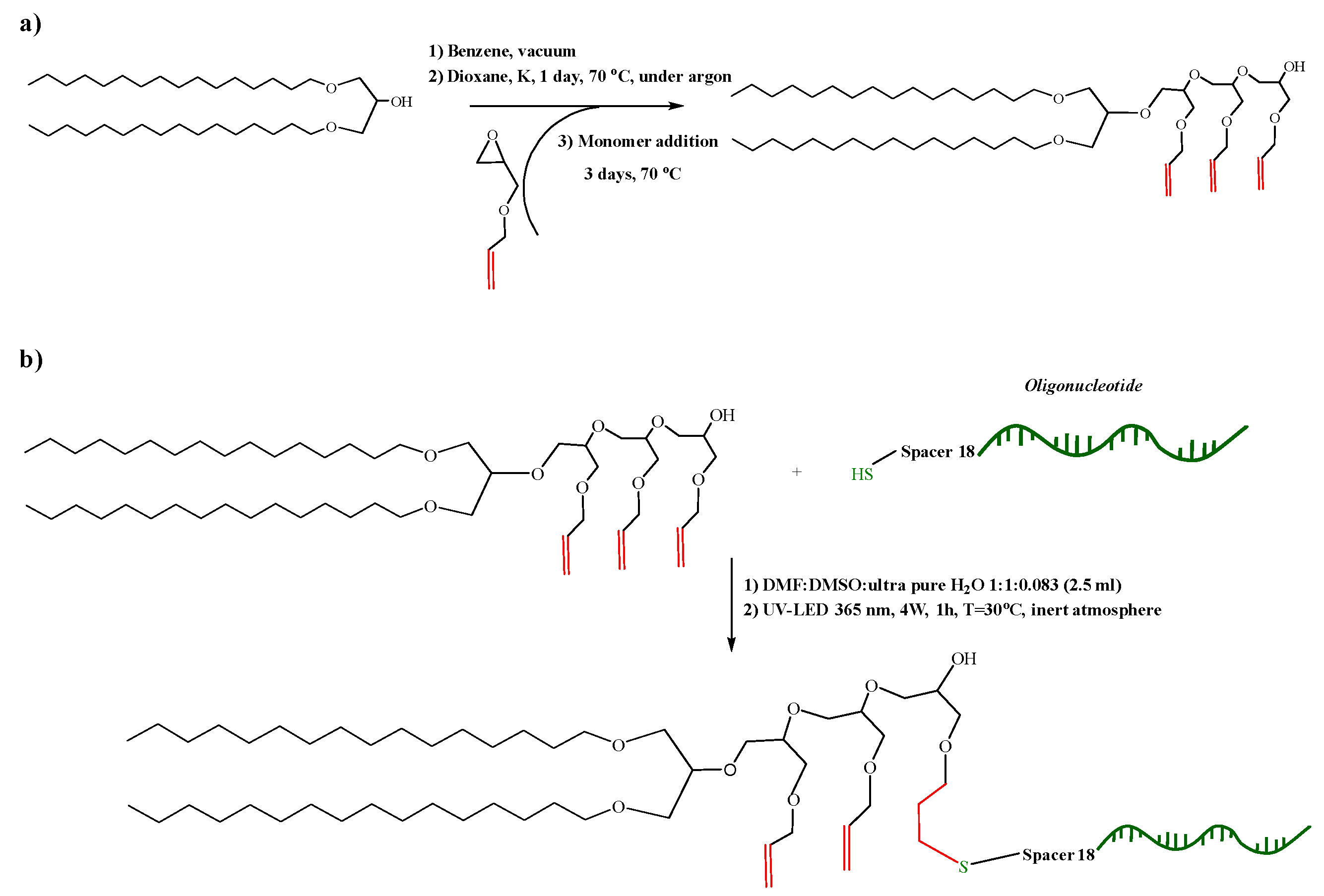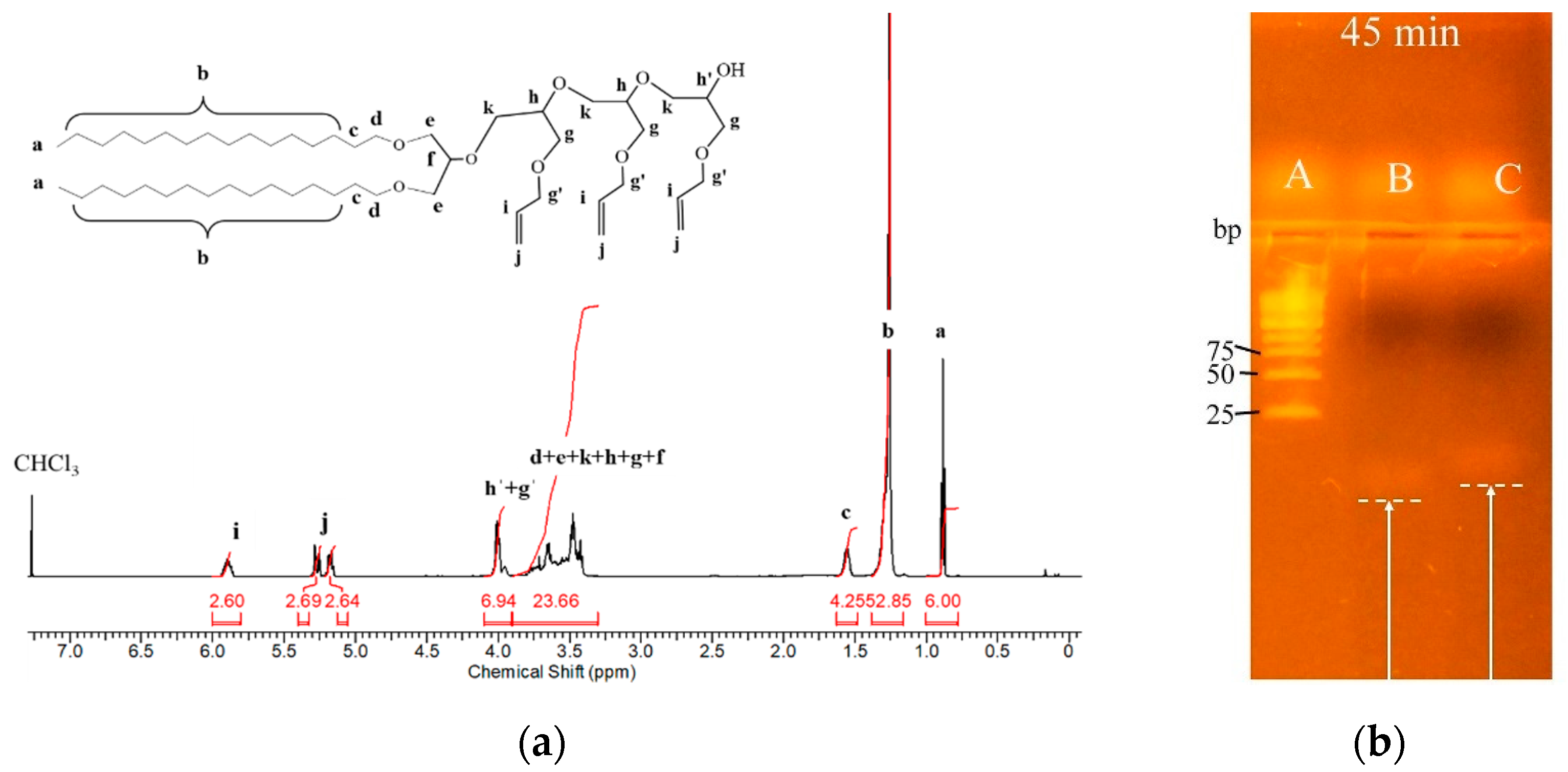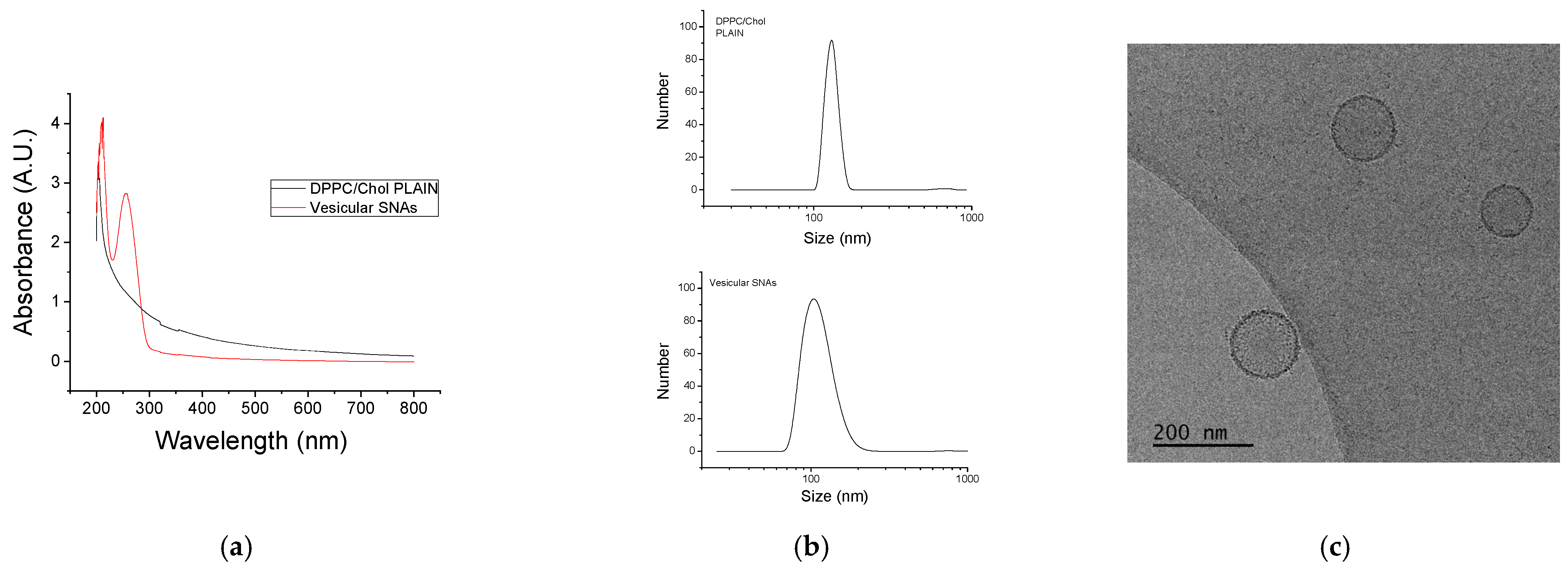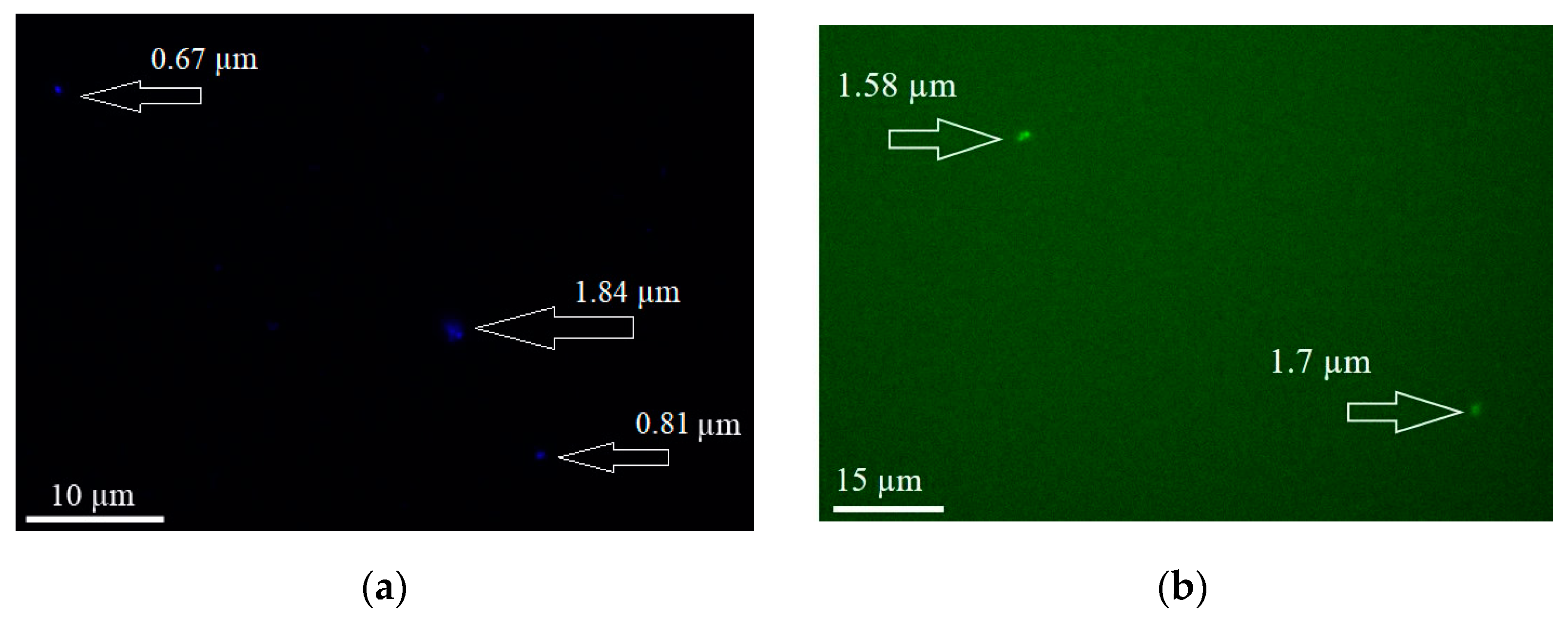Original Synthesis of a Nucleolipid for Preparation of Vesicular Spherical Nucleic Acids
Abstract
1. Introduction
2. Materials and Methods
3. Results and Discussion
3.1. Synthesis and Characterization of the Nucleolipid
3.2. Preparation of Vesicular SNAs
4. Conclusions
Supplementary Materials
Author Contributions
Funding
Acknowledgments
Conflicts of Interest
References
- Cutler, J.I.; Auyeung, E.; Mirkin, C.A. Spherical Nucleic Acids. J. Am. Chem. Soc. 2012, 134, 1376–1391. [Google Scholar] [CrossRef] [PubMed]
- Mokhtarzadeh, A.; Vahidnezhad, H.; Youssefian, L.; Mosafer, J.; Baradaran, B.; Uitto, J. Applications of Spherical Nucleic Acid Nanoparticles as Delivery Systems. Trends Mol. Med. 2019, 25, 1066–1079. [Google Scholar] [CrossRef] [PubMed]
- Banga, R.J.; Krovi, S.A.; Narayan, S.P.; Sprangers, A.J.; Liu, G.; Mirkin, C.A.; Nguyen, S.T. Drug-loaded Polymeric Spherical Nucleic Acids: Enhancing Colloidal Stability and Cellular Uptake of Polymeric Nanoparticles through DNA Surface-functionalization. Biomacromolecules 2017, 18, 483–489. [Google Scholar] [CrossRef] [PubMed]
- Williams, S.C.P. Spherical nucleic acids: A whole new ball game. Proc. Natl. Acad. Sci. USA 2013, 110, 13231–13233. [Google Scholar] [CrossRef] [PubMed]
- Song, Y.; Song, W.; Lan, X.; Cai, W.; Jiang, D. Spherical nucleic acids: Organized nucleotide aggregates as versatile nanomedicine. Aggregate 2022, 3, e120. [Google Scholar] [CrossRef] [PubMed]
- Zheng, D.; Giljohann, D.A.; Chen, D.L.; Massich, M.D.; Wang, X.-Q.; Iordanov, H.; Mirkin, C.A.; Paller, A.S. Topical delivery of siRNA-based spherical nucleic acid nanoparticle conjugates for gene regulation. Proc. Natl. Acad. Sci. USA 2012, 109, 11975–11980. [Google Scholar] [CrossRef]
- Briley, W.; Halo, T.L.; Randeria, P.S.; Alhasan, A.H.; Auyeung, E.; Hurst, S.J.; Mirkin, C.A. Biochemistry and Biomedical Applications of Spherical Nucleic Acids (SNAs). In Nanomaterials for Biomedicine; Nagarajan, R., Ed.; ACS Symposium Series; American Chemical Society: Washington, DC, USA, 2012; pp. 1–20. [Google Scholar]
- Banga, R.J.; Meckes, B.; Narayan, S.P.; Sprangers, A.J.; Nguyen, S.T.; Mirkin, C.A. Cross-Linked Micellar Spherical Nucleic Acids from Thermoresponsive Templates. J. Am. Chem. Soc. 2017, 139, 4278–4281. [Google Scholar] [CrossRef] [PubMed]
- Giljohann, D.A.; Seferos, D.S.; Prigodich, A.E.; Patel, P.C.; Mirkin, C.A. Gene regulation with polyvalent siRNA-nanoparticle conjugates. J. Am. Chem. Soc. 2009, 131, 2072–2073. [Google Scholar] [CrossRef] [PubMed]
- Seferos, D.S.; Prigodich, A.E.; Giljohann, D.A.; Patel, P.C.; Mirkin, C.A. Polyvalent DNA Nanoparticle Conjugates Stabilize Nucleic Acids. Nano Lett. 2009, 9, 308–311. [Google Scholar] [CrossRef] [PubMed]
- Barnaby, S.N.; Sita, T.L.; Petrosko, S.H.; Stegh, A.H.; Mirkin, C.A. Therapeutic applications of spherical nucleic acids. Cancer Treat. Res. 2015, 166, 23–50. [Google Scholar] [CrossRef] [PubMed]
- Benizri, S.; Gissot, A.; Martin, A.; Vialet, B.; Grinstaff, M.W.; Barthélémy, P. Bioconjugated Oligonucleotides: Recent Developments and Therapeutic Applications. Bioconjug. Chem. 2019, 30, 366–383. [Google Scholar] [CrossRef] [PubMed]
- Kapadia, C.H.; Melamed, J.R.; Day, E.S. Spherical Nucleic Acid Nanoparticles: Therapeutic Potential. BioDrugs 2018, 32, 297–309. [Google Scholar] [CrossRef] [PubMed]
- Liu, H.; Kang, R.S.; Bagnowski, K.; Yu, J.M.; Radecki, S.; Daniel, W.L.; Anderson, B.R.; Nallagatl, S.; Schook, A.; Agarwal, R.; et al. Targeting the IL-17 Receptor Using Liposomal Spherical Nucleic Acids as Topical Therapy for Psoriasis. J. Investig. Dermatol. 2020, 140, 435–444. [Google Scholar] [CrossRef] [PubMed]
- Choi, C.H.; Hao, L.; Narayan, S.P.; Auyeung, E.; Mirkin, C.A. Mechanism for the endocytosis of spherical nucleic acid nanoparticle conjugates. Proc. Natl. Acad. Sci. USA 2013, 110, 7625–7630. [Google Scholar] [CrossRef] [PubMed]
- Bakardzhiev, P.; Toncheva-Moncheva, N.; Mladenova, K.; Petrova, S.; Videv, P.; Moskova-Doumanova, V.; Topouzova-Hristova, T.; Doumanov, J.; Rangelov, S. Assembly of amphiphilic nucleic acid-polymer conjugates into complex superaggregates: Preparation, properties, and in vitro performance. Eur. Polym. J. 2020, 131, 109692. [Google Scholar] [CrossRef]
- Haladjova, E.; Ugrinova, I.; Rangelov, S. One-pot Synthesis of Oligonucleotide-Grafted Polymeric Nanoparticles. Soft Matter 2020, 16, 191–199. [Google Scholar] [CrossRef] [PubMed]
- Hong, B.J.; Eryazici, I.; Bleher, R.; Thaner, R.V.; Mirkin, C.A.; Nguyen, S.T. Directed Assembly of Nucleic Acid-Based Polymeric Nanoparticles from Molecular Tetravalent Cores. J. Am. Chem. Soc. 2015, 137, 8184–8191. [Google Scholar] [CrossRef] [PubMed]
- Hao, Y.; Li, Y.; Song, L.; Deng, Z. Flash Synthesis of Spherical Nucleic Acids with Record DNA Density. J. Am. Chem. Soc. 2021, 143, 3065–3069. [Google Scholar] [CrossRef] [PubMed]
- Melamed, J.R.; Kreuzberger, N.L.; Goyal, R.; Day, E.S. Spherical nucleic acid architecture can improve the efficacy of polycation-mediated siRNA delivery. Mol. Ther. Nucleic Acids 2018, 12, 207–219. [Google Scholar] [CrossRef]
- Rische, C.H.; Goel, A.; Radovic-Moreno, A.F.; Gryaznov, S.M. Antibacterial silver core spherical nucleic acids. Mater. Today Commun. 2016, 9, 30–40. [Google Scholar] [CrossRef]
- Zhang, C.; Hao, L.; Calabrese, C.M.; Zhou, Y.; Choi, C.H.J.; Xing, H.; Mirkin, C.A. Biodegradable DNA-Brush Block Copolymer Spherical Nucleic Acids Enable Transfection Agent-Free Intracellular Gene Regulation. Small 2015, 11, 5360–5368. [Google Scholar] [CrossRef] [PubMed]
- Sprangers, A.J.; Hao, L.; Banga, R.J.; Mirkin, C.A. Liposomal Spherical Nucleic Acids for Regulating Long Noncoding RNAs in the Nucleus. Small 2017, 13, 1602753. [Google Scholar] [CrossRef] [PubMed]
- Callmann, C.E.; Kusmierz, C.D.; Dittmar, J.W.; Broger, L.; Mirkin, C.A. Impact of Liposomal Spherical Nucleic Acid Structure on Immunotherapeutic Function. ACS Cent. Sci. 2021, 7, 892–899. [Google Scholar] [CrossRef]
- Krishnamoorthy, K.; Hoffmann, K.; Kewalramani, S.; Brodin, J.D.; Moreau, L.M.; Mirkin, C.A.; de la Cruz, M.O.; Bedzyk, M.J. Defining the Structure of a Protein–Spherical Nucleic Acid Conjugate and Its Counterionic Cloud. ACS Cent. Sci. 2018, 4, 378–386. [Google Scholar] [CrossRef] [PubMed]
- Banga, R.J.; Chernyak, N.; Narayan, S.P.; Nguyen, S.T.; Mirkin, C.A. Liposomal spherical nucleic acids. J. Am. Chem. Soc. 2014, 136, 9866–9869. [Google Scholar] [CrossRef] [PubMed]
- Dimitrov, E.; Toncheva-Moncheva, N.; Bakardzhiev, P.; Forys, A.; Doumanov, J.; Mladenova, K.; Petrova, S.; Trzebicka, B.; Rangelov, S. Nucleic Acid-Based Supramolecular Structures: Vesicular Spherical Nucleic Acids from a Non-Phospholipid Nucleolipid. Nanoscale Adv. 2022, in press. [CrossRef]
- Ferrer, J.R.; Sinegra, A.J.; Ivancic, D.; Yeap, X.Y.; Qiu, L.; Wang, J.-J.; Zhang, Z.J.; Wertheim, J.A.; Mirkin, C.A. Structure-Dependent Biodistribution of Liposomal Spherical Nucleic Acids. ACS Nano 2020, 14, 1682–1693. [Google Scholar] [CrossRef]
- Pickens, C.J.; Johnson, S.N.; Pressnall, M.M.; Leon, M.A.; Berkland, C.J. Practical Considerations, Challenges, and Limitations of Bioconjugation via Azide–Alkyne Cycloaddition. Bioconjug. Chem. 2018, 29, 686–701. [Google Scholar] [CrossRef]
- Kanan, M.W.; Rozenman, M.M.; Sakural, K.; Snyder, T.M.; Liu, D.R. Reaction discovery enabled by DNA-templated synthesis and in vitro selection. Nature 2004, 431, 545–549. [Google Scholar] [CrossRef]
- Provencher, S.W. Inverse Problems in Polymer Characterization: Direct Analysis of Polydispersity with Photon Correlation Spectroscopy. Macromol. Chem. 1979, 180, 201–209. [Google Scholar] [CrossRef]
- Mladenov, N.; Petrova, S.D.; Mladenova, K.; Bozhinova, D.; Moskova-Doumanova, V.; Topouzova-Hristova, T.; Videv, P.; Veleva, R.; Kostadinova, A.; Staneva, G.; et al. Miscibility of hBest1 and sphingomyelin in surface films—A prerequisite for interaction with membrane domains. Colloids Surf. B Biointerfaces 2020, 189, 110893. [Google Scholar] [CrossRef] [PubMed]
- Solomantin, S.; Herschlag, D. Methods of Site-Specific Labeling of RNA with Fluorescent Dyes. In Methods Enzymology Book Series. Biophysical, Chemical, and Functional Probes of RNA Structure, Interactions and Folding: Part B; Herschlag, D., Ed.; Elsevier: San Diego, CA, USA, 2009; Volume 469, Chapter 3; pp. 47–68. [Google Scholar]
- Rangelov, S.; Petrova, E.; Berlinova, I.; Tsvetanov, C. Synthesis and Polymerization of Novel Oxirane Bearing an Aliphatic Double Chain Moiety. Polymer 2001, 42, 4483–4491. [Google Scholar] [CrossRef]
- Bakardzhiev, P.; Rangelov, S.; Trzebicka, B.; Momekova, D.; Lalev, G. Nanostructures by Self-Assembly of Polyglycidol-Derivatized Lipids. RSC Adv. 2014, 4, 37208–37219. [Google Scholar] [CrossRef]
- Stoyanova, B.; Novakov, C.; Tsvetanov, C.; Rangelov, S. Synthesis and Aqueous Solution Properties of Block Copolyethers with Latent Chemical Functionality. Macrom. Chem. Phys. 2016, 217, 2380–2390. [Google Scholar] [CrossRef]
- Hoyle, C.E.; Bowman, C.N. Thiol–Ene Click Chemistry. Angew. Chem. Int. Ed. 2010, 49, 1540–1573. [Google Scholar] [CrossRef] [PubMed]
- Olmsted, J.; Kearns, D.R. Mechanism of ethidium bromide fluorescence enhancement on binding to nucleic acids. Biochemistry 1977, 16, 3647–3654. [Google Scholar] [CrossRef] [PubMed]
- Shen, C.-H. Diagnostic Molecular Biology. In Detection and Analysis of Nucleic Acids; Shen, C.-H., Ed.; Academic Press: New York, NY, USA, 2019; Chapter 7; pp. 167–185. [Google Scholar]
- Hristova, K.; Needham, D. Phase behavior of lipid/polymer-lipid mixture in aqueous medium. Macromolecules 1995, 28, 991–1002. [Google Scholar] [CrossRef]
- Nagle, J.F.; Tristram-Nagle, S. Structure of lipid bilayers. Biochim. Biophys. Acta 2000, 1469, 159–195. [Google Scholar] [CrossRef]
- Cutler, J.; Zheng, D.; Xu, X.; Giljohann, D.; Mirkin, C.A. Polyvalent Oligonucleotide Iron Oxide Nanoparticle “Click” Conjugates. Nano Lett. 2010, 10, 1477–1480. [Google Scholar] [CrossRef]
- Kusmierz, C.D.; Bujold, K.E.; Callmann, C.E.; Mirkin, C.A. Defining the Design Parameters for In Vivo Enzyme Delivery through Protein Spherical Nucleic Acids. ACS Cent. Sci. 2020, 6, 815–822. [Google Scholar] [CrossRef]
- Zhu, S.; Xing, H.; Gordiichuk, P.; Park, J.; Mirkin, C.A. PLGA Spherical Nucleic Acids. Adv. Mater. 2018, 30, 1707113. [Google Scholar] [CrossRef] [PubMed]
- Calabrese, C.M.; Merkel, T.J.; Briley, W.E.; Randeria, P.S.; Narayan, S.P.; Rouge, J.L.; Walker, D.A.; Scott, A.W.; Mirkin, C.A. Biocompatible infinite-coordination-polymer nanoparticle-nucleic-acid conjugates for antisense gene regulation. Angew. Chem. Int. Ed. 2015, 54, 476–480. [Google Scholar] [CrossRef]
- Hurst, S.J.; Lytton-Jean, A.K.R.; Mirkin, C.A. Maximizing DNA Loading on a Range of Gold Nanoparticle Sizes. Anal. Chem. 2006, 78, 8313–8318. [Google Scholar] [CrossRef] [PubMed]
- Escorihuela, J.; Banuls, M.-J.; Puchades, R.; Maquieira, A. Development of Oligonucleotide Microarrays onto Si-Based Surfaces via Thioether Linkage Mediated by UV Irradiation. Bioconjug. Chem. 2012, 23, 2121–2128. [Google Scholar] [CrossRef]
- Hill, H.D.; Millstone, J.E.; Banholzer, M.J.; Mirkin, C.A. The role radius of curvature plays in thiolated oligonucleotide loading on gold. ACS Nano 2009, 3, 418–424. [Google Scholar] [CrossRef] [PubMed]
- Alexander, S. Adsorption of chain molecules with a polar head a scaling description. J. Phys. France 1977, 38, 983–987. [Google Scholar] [CrossRef]
- De Gennes, P. Conformations of Polymers Attached to an Interface. Macromolecules 1980, 13, 1069–1075. [Google Scholar] [CrossRef]
- Bagatolli, L.A. To See or Not to See: Lateral Organization of Biological Membranes and Fluorescence Microscopy. Biochim. Biophys. Acta 2006, 1758, 1451–1456. [Google Scholar] [CrossRef]
- Basu, S.; Dasgupta, N.N. Spectrophotometric Investigation of DNA in the Ultraviolet. Biochim. Biophys. Acta 1967, 145, 391–397. [Google Scholar] [CrossRef]
- Tankovskaia, S.A.; Kotb, O.M.; Dommes, O.A.; Paston, S.V. DNA Damage Induced by Gamma-Radiation Revealed from UV Absorption Spectroscopy. J. Phys. Conf. Ser. 2018, 1038, 012027. [Google Scholar] [CrossRef]
- Flory, P.J. Principles of Polymer Chemistry; Cornell University Press: Ithaca, NY, USA, 1953. [Google Scholar]





| Rh * (nm) | ζ Potential (mV) | Number of Strands per Vesicle | Surface Coverage | ||
|---|---|---|---|---|---|
| (nm−2) | pmol·cm−2 | ||||
| Plain DPPC/Chol liposomes | n.a. | n.a. | |||
| 67.4 ± 3.4 | –0.34 ± 0.01 | n.a | |||
| (0.087) | |||||
| Vesicular SNAs | 57.1 ± 2.9 | –9.11 ± 0.36 | 3880 ± 194 | 0.047 | 7.8 |
| (0.127) | |||||
Publisher’s Note: MDPI stays neutral with regard to jurisdictional claims in published maps and institutional affiliations. |
© 2022 by the authors. Licensee MDPI, Basel, Switzerland. This article is an open access article distributed under the terms and conditions of the Creative Commons Attribution (CC BY) license (https://creativecommons.org/licenses/by/4.0/).
Share and Cite
Dimitrov, E.; Toncheva-Moncheva, N.; Bakardzhiev, P.; Forys, A.; Doumanov, J.; Mladenova, K.; Petrova, S.; Trzebicka, B.; Rangelov, S. Original Synthesis of a Nucleolipid for Preparation of Vesicular Spherical Nucleic Acids. Nanomaterials 2022, 12, 3645. https://doi.org/10.3390/nano12203645
Dimitrov E, Toncheva-Moncheva N, Bakardzhiev P, Forys A, Doumanov J, Mladenova K, Petrova S, Trzebicka B, Rangelov S. Original Synthesis of a Nucleolipid for Preparation of Vesicular Spherical Nucleic Acids. Nanomaterials. 2022; 12(20):3645. https://doi.org/10.3390/nano12203645
Chicago/Turabian StyleDimitrov, Erik, Natalia Toncheva-Moncheva, Pavel Bakardzhiev, Aleksander Forys, Jordan Doumanov, Kirilka Mladenova, Svetla Petrova, Barbara Trzebicka, and Stanislav Rangelov. 2022. "Original Synthesis of a Nucleolipid for Preparation of Vesicular Spherical Nucleic Acids" Nanomaterials 12, no. 20: 3645. https://doi.org/10.3390/nano12203645
APA StyleDimitrov, E., Toncheva-Moncheva, N., Bakardzhiev, P., Forys, A., Doumanov, J., Mladenova, K., Petrova, S., Trzebicka, B., & Rangelov, S. (2022). Original Synthesis of a Nucleolipid for Preparation of Vesicular Spherical Nucleic Acids. Nanomaterials, 12(20), 3645. https://doi.org/10.3390/nano12203645










